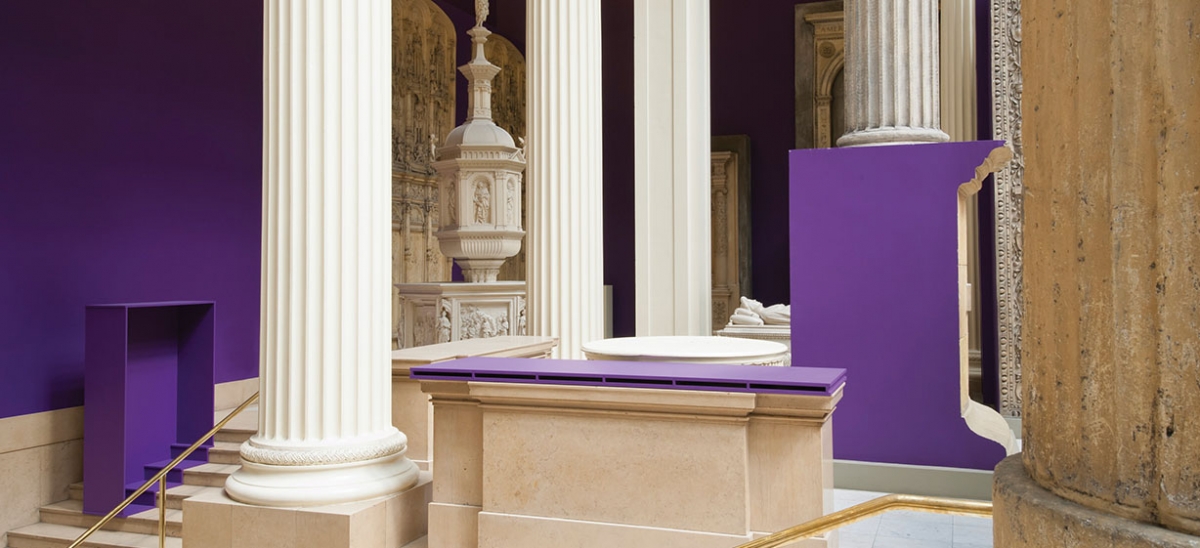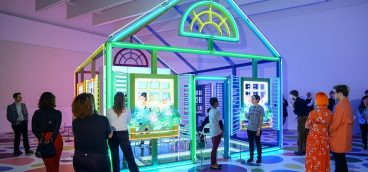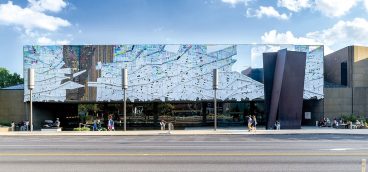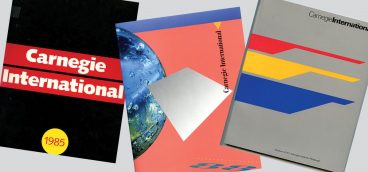
Let me say at the beginning that I adore the current Carnegie International, curated by Daniel Baumann, Dan Byers and Tina Kukielski. It has made me change my mind about a number of things I have held dear in the past. And, to me at least, it is already old hat, because for nearly two years now I have been engaged, with lots of other interested people, in the discussions that culminated in the opening weekend of early October.
Previous Internationals have been kept securely under wraps, and I remember being sternly warned earlier by one of the curators not to talk too openly about aspects of the prospective show to which I had become privy (the “polite” embargo). Somehow that started to change a little after that warning. When she came here a while ago, museum Director Lynn Zelevansky indicated she wanted the museum’s dealings to be “transparent” (welcome to the Byzantine Empire). So this International is the first to evolve under the public gaze, and it is the better for it.
Three curators, outgoing and young, living democratically in the community and engaging it, fulfilled Zelevansky’s desire that the show have to do with Pittsburgh itself and not simply fixate on the monotonous horizon of internationalism as seen in countless other burgeoning exhibitions. In the museum, the galleries were rehung subtly to suggest how 107 years of the museum’s existence had been served by this serial exhibitionism. (I wrote of this in the fall issue of Pittsburgh Quarterly.)
Outside the museum, an apartment was leased in hip Lawrenceville for the run-up and the duration of the International. There artists might stay, and regular meetings, talks and discussions might take place. The topics were broad and speculative: artists and students doing show-and-tells, some drinking and smoking, the usual stuff. (These happenings are documented in the catalog to the exhibitions… amazingly printed before the exhibition.) This dismantling of The Carnegie’s reputation as a dowager, has been successfully achieved at a distance in Lawrenceville. And it has also been achieved on its own campus, best highlighted at the gala opening on Oct. 4, where the thinning cold front of the establishment met the warm front—more than 1,000 younger art enthusiasts. A hearse drew up, bearing a coffin carried by hunks, which was introduced into the marble halls and opened to reveal a celebrated drag queen, who, “speaking truth to power,” proceeded to castigate the governor of the commonwealth. The symbolism may not have been lost. No blood was spilled, Pinkerton’s men not enlisted.
That performance, like Renaissance masques, manifests one thematic thread of this exhibition—play. It undercuts the reverence that dowagers sometimes expect to be shown them, and the art of the 21st century has little tolerance for reverence. A multicolored serpent, a thing of the children’s playground, unfolded outside the museum in the summer. It was and is grossly intrusive, if forgivably subversive. It may not be for all seasons, but it has a current potency. At the very perimeter of the museum, the man and the child exchange ideas. I would almost have liked to see the “Lozziwurm” (for that is its name) penetrate the building, where the notion of playfulness is more variously explored. Outside, next to the worm, a more elaborate play unfolded. The monumental sculpture, “TIP,” 2013, by the Royal Academician Phyllida Barlow, a temporary extravaganza of counterbalanced logs and streamers, blows a raspberry at Richard Serra’s stoic “Carnegie,” 1985 in immortal Cor-ten steel. The work of her countryman, Henry Moore, whose “Reclining Figure,” 1957, sits by the fountains, is for once (I think lightheartedly) dwarfed by “TIP.”
Inside, in the Heinz Architectural Center is a small, curated exhibition discussing the role of the playground, which has been supplemented by two CI artists, Tezuka Architects and Ei Arakawa with Henning Bohl. (The Playground Project is curated by Gabriela Burkhalter.)
Beyond the ideas of play, Pittsburgh, and the history of the International, the curators do not assert any further agendum, beyond what they say toward the end of the jointly written introduction. “We realized that all three of us shared an interest in the idea of the museum as a site for a unique kind of optimistic, potentially destabilizing experience, with great political import. Many assume that museums are boring, stiff, conservative storehouses of yesterday. But we argue they are important actors in the world, upholding memory and writing history, and acting as vital public sites for exposure, discourse, pleasure, and confrontation in the urban fabric…”
This is best seen in their choice of artists (nearly 40) drawn from all over the world, even the grave. The artists speak with their own, voluntary voices, and take praise or blame for that. In the museum, their work is to some extent site-specific, but I am not entirely certain that all the sites are ideal. I thought, on first glance, that nothing could be more inappropriate than to find Wade Guyton’s work in the spectacular Founder’s Room (where museum-goers may remember that, in Laura Hoptman’s 2004 International, Maurizio Cattelan introduced an open coffin containing an effigy of J.F. Kennedy). On second glance it occurred to me that Guyton was taking on its Beaux-Arts polish (or possibly Andrew Carnegie himself) with his wonkily printed photocopies on canvas. This must surely amount to a well-known finger gesture. Nor was the great maw of the grand staircase ideal to show Rokni Haerizadeh’s wicked, perverse and discriminating watercolors or Tobias Madison’s collaborations with the residents of Wilkinsburg.
Not so with both the Hall of Sculpture (upper level) and the Hall of Architecture. Nicole Eisenman’s paintings are wryly enlisted to aspire to the heroic spaces of the walls… NOT! And her more recent sculptures, like casts of bodies incinerated in Pompeii and Herculaneum, engage the plinths next to the reproduction statuary that were first shown in the first International of 1896 in a kind of sparring match. In the Hall of Architecture, another vestige of early Carnegie taste, with its massive architectural casts of patinated plaster, Gabriel Sierra introduces flat expanses of Tyrian purple on selected flat surfaces and introduced material, subversively finding art in all the wrong places.
For the most part, the siting of the work in the museum is made easier by the accommodations of modern architecture. The Scaife Wings and the Heinz Galleries are purpose-built for this, and there are a few fortuitous grabs: The cloakroom (the most desultory spot in the entire museum) goes to Wade Guyton; let it remain a gallery space henceforth. The Scaife Wing, occupied with tracing the history of the International, is little interrupted except for a smashing Rodney Graham: “The Pipe Cleaner Artist, Amalfi, ’61,” 2013. In the works on paper gallery in Scaife is a body of work that I found the most interesting on so many levels: the work of Mladen Stilinovic (who was born in Yugoslavia, now Serbia, and is working in what is now Croatia) is almost presented as a retrospective—living through the changes in the area beyond the Iron Curtain. I was reminded of the ancient Chinese curse, “May you live in interesting times.”
The Heinz Galleries, those big, white elephantine spaces, as usual present the classic contemporary hang, and it is made or broken by the juxtaposition of the works. It’s pretty good, perhaps a little overcrowded and episodic.
I’ve been reading Victoria Newhouse’s 2006 book “Art and the Power of Placement,” which has on its cover the Louvre’s “Nike of Samothrace,” located at the top of its magnificent staircase. In the Scaife Lounge, at the top of The Carnegie’s main staircase, is Mark Leckey’s “Pearl Vision,” 2012, a massively scaled video of the artist playing a snare drum. It is a tour de force. Another piece by Leckey, in the Wertz Gallery in the Museum of Natural History, is also carefully and architecturally placed with a different sense of scale and place. Since it is a little hidden from the rest of the show, don’t fail to check it out (with Pierre Leguillon’s diorama “Jean Dubuffet Typographer,” 2013, even more sequestered in the Hall of Botany).
As with this year’s Venice Biennale, the hand of the “outsider” artist is sensed in this show, most noticeably with Pierre Leguillon’s “A Vivarium of George E. Ohr,” 2013, Guo Fengyi’s obsessive scroll paintings, and the posthumous presence of the great visionary, Joseph Yoakum. Henry Taylor’s large canvases highlight the African-American contribution to this field. (All located in the Heinz Galleries.)
This International also echoes its 1991 predecessor, which was organized by Mark Francis and Lynne Cooke, who radically sought to present the exhibition outside the museum’s physical confines. Now, Baumann, Byers and Kukielski have lighted upon the blighted communities of Wilkinsburg, Homestead and Braddock, all of which are in varying stages of recovery. The most lasting outreach is being organized by the artist collective Transformazium, which is creating an Art Lending Collection to be based in the Carnegie Library in Braddock (site of the industrialist’s first steel mill and U.S. library) and includes work by the artists in the International. A simple library card entitles the bearer to a loan. Photography and video work done in Homestead and Wilkinsburg (Zoe Strauss and Tobias Madison, respectively) is essentially collaborative with the sitters and participants from those neighborhoods. The results will be permanently housed in the Museum of Art in Oakland at the close of the International.
Although written by an artist, Grayson Perry’s Reith lecture (referred to at the top of this essay) might sum up the engaged person’s concerns with contemporary art, and it might do so more directly than the curators of this International might care to express.
Although this incarnation of the International, rather like the previous ones, has a necessary relationship with the art trade, it feels less complicit. This is in contrast with the dealerish/entrepreneurial models other museums are beginning to adopt. (In Pittsburgh, noticeably, we have the ambitions of its sister institution, the Andy Warhol Museum).
Much of the work being exhibited may not survive the run of the show. Lara Favaretto’s confetti sculptures are designed to fall apart, and the massive sculpture by Phyllida Barlow may be dismantled or destroyed; by all accounts she doesn’t feel strongly about it either way and is resigned to fate.
At the press opening of this International, I was caught up in conversation with someone from out of town, who, like me, knew each of the curators and was wondering which artists had been introduced into the mix by which curator. We knew the answer in a number of cases easily enough, but we agreed that in the final analysis it didn’t signify. The show verges on the seamless and seems to achieve the aims, intentions and aspirations of all its organizers. It is an International grounded in its own sense of place, just as today, after many years of uncertainty, Pittsburgh is again comfortable in its new skin.





